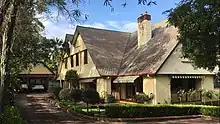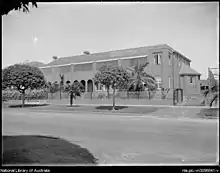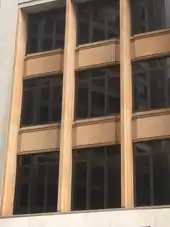Thomas Pollard Sampson
Thomas Pollard Sampson (24 June 1875 – 25 June 1961) was a Tasmanian-born Australian architect active in New South Wales during the first forty years of the 20th century. His work encompassed the styles of the Federation Arts and Crafts and Bungalow through to the Inter-War Styles.[1] In 1912 he designed an octagonal roofed stadium at Rushcutters Bay that seated up to 12,000 spectators. At the time, the Sydney Stadium was said to be "the largest roofed-in structure in the world."[2] In the 1920s and 1930s, as a golfer and member of Concord Golf Club and Pennant Hills Golf Club, he designed the clubhouses at both courses. The buildings of both these well known Sydney clubs are still in use in 2023.[3][4]
Thomas Pollard Sampson | |
|---|---|
 | |
| Born | 24 June 1875 Launceston, Tasmania |
| Died | 25 June 1961 (aged 86) Paddington, New South Wales, Australia |
| Other names | T. P. Sampson |
| Education | Launceston High School |
| Occupation | Architect |
| Known for | Architecture |
| Spouse | Clarice Effie Henderson |
| Children | 1 |
| Relatives | Senator Burford Sampson cousin |
Family and life
Sampson was born in Launceston, Tasmania, to Richard Sampson (c.1847–1917) and Caroline Elizabeth Pollard (1849–1945). His maternal grandparents were from Yorkshire, England, and his extended family were members of the Methodist Church. He attended the independent school known as Launceston High School that existed from 1884 until 1912. It was founded by Edward Alleyne Nathan who had been a teacher at Launceston Church Grammar School. The school was at Milton Hall in Frederick Street, Launceston, and eventually merged with Launceston Church Grammar School.[5] The alumni of both schools held joint reunions as the Old Launcestonians' Association after the schools merger and Sampson attended these reunions in Sydney.[6]
On moving to Sydney in 1909, Sampson lived in Manly and for a short period in Kirribilli. He married Clarice Henderson on 17 February 1911 at St Philip's Church, Sydney and after the wedding the young couple lived at the Henderson family home "Youngarra" in Gordon Street, Burwood.[7] Sampson and his wife had one daughter, Phyllis (Phyl) Marjorie Sampson, who was born on 8 August 1911 in Sydney. The Sampson family then rented a house at 47 Ashburner Street, Manly, in the 1920s. From the 1930s, until his death, Sampson lived in a flat at Craigievar in Darling Point. He died on 25 Jun 1961 at the Scottish Hospital, Paddington.[8]
In February 1932, at Woollahra, his daughter Phyl married Paul Cohen a son of Sir Samuel and Lady Cohen.[9] The marriage produced twins, Christopher and Dinah Cohen. In 1941, Paul Cohen changed his Jewish name and those of his family to Cullen. He was fighting the Germans in North Africa, Greece and Crete and knew that, were he captured he would not be treated as a Prisoner of War.[10] The marriage ended in divorce in 1961. Phyl Cullen died on 22 October 2011 in Elizabeth Bay, New South Wales, aged 100 years.
Career
Sampson was articled in architecture to A.E. Luttrell of Cameron Street, Launceston[11] In 1891 Sampson exhibited an architectural drawing of a design for a villa residence in the Tasmanian Industrial Exhibition. He had been articled for six months at that time and had become an architectural photographer taking many notable images of Launceston buildings. Sampson moved to Sydney to practise as an architect. In 1907 he designed a row of three houses in Manly, New South Wales.[12] In 1911 Charles A Henderson offered his son-law land on his subdivision at Strathfield. Sampson designed houses and rented them before selling the properties.[13] In 1919 he partnered with Harold Minton Taylor, a solicitor, and purchased 'Rosebank House', Darlinghurst, and adjoining land.[14] They demolished the original house and constructed several apartment blocks, including Upton Court in Forbes Street. Sampson also designed the buildings for Henderson's Hats at Surry Hills and Rosebery.[15] Whilst living with the Henderson family his daughter started school at Meriden where Sampson did a substantial amount of work on the school's Redmyre Road campus in Strathfield.[16] He was also involved in the marketing of a subdivision of land at Neutral Bay. Sampson worked with other architects early in his career including Herbert Dennis,[17] Robertson & Marks and Nixon & Adam. After designing the stadium for Hugh D. McIntosh he worked on his home, Belhaven in Bellevue Hill, and on investment properties for him.[18] In 1924 Sampson designed a house at 3 Nicholson Street, Burwood, for Charles David Murray (1872–1936)[19] who had just become managing director of Murray and Company Ltd, Universal Providers.[20] It was one of three substantial homes, on the northern and high point of the street, that had tennis courts and orchards. The Murray house and its neighbours were all demolished in the 1970s for the creation of St. Paul’s Close, Burwood. The replacement houses are all in Late twentieth century Australian and immigrants’ nostalgic style.[21][22] During World War Two Sampson worked for Manpower Directorate (Australia) and did early work at Concord Repatriation General Hospital. After his daughter's marriage into the Cohen family Sampson worked for them designing houses in Woollahra and office buildings in Sydney.[23]
Notable works
- R.C. Henderson Hat Manufactures, wharehouse and office, 11–13 Randle Street Surry Hills (1912 burnt out 2023)[24][25]
- The Austral Hotel, Victoria Street, Darlinghurst (Kings Cross) (1912) alterations and additions demolished in 1936 and replaced by the Piccadilly Hotel[26]
- Sydney Stadium, Neild Avenue, Rushcutters Bay. (1912, demolished 1970)[2]
- Kama, house, 16 Llandilo Avenue, Strathfield (1913)[27]
- 105 Bower Street Manly (1914) [28]
- Romahapa, house, 22–24 Martin Road, Centennial Park (1914)[29][30]
- Villa Regina, house, Neutral Bay (1915 demolished c1976)[31]
- Houses, 86, 88 and 90 Beresford Road, Bellevue Hill (1914)[32]
- House, 11 Kingsland Avenue, Strathfield, New South Wales (1915)[33]
- Former Commonwealth Hotel, 461 Elizabeth Street, Surry Hills (1919, facade only remains)[34]
- Upton Court, 12 residential flats, 186 Forbes Street, Darlinghurst (1919)[35][36]
- Concord Golf Club Clubhouse, Concord (1921)[37]
- Derwent, 117 Homebush Road, Strathfield (1924)
- Murray House, 3 Nicholson Street, Burwood (1924 demolished 1970s)[38]
- Grantchester, 6 residential flats, 420 Edgecliff Road, Edgecliff (1926)[39]
- Pennant Hills Golf Club Clubhouse, Beecroft, New South Wales (1925/1929/1939)[40]
- Houses, 2 Wallis Avenue, Strathfield (demolished) 18 Wallis Avenue, Strathfield (derelict) (1927)
- Western Suburbs Builders' Exchange, 353–355 Liverpool Road Ashfield (1929) [41]
- House, 66 Wallaroy Road, Woollahra, New South Wales (1933)[42]
- Orwell, 3 Turuga Street, Turramurra, New South Wales (1933)[43][44][45]
- Wallis Hall, Meriden School, Strathfield (1936)[46]
- Insurance House, 263 George Street, Sydney (1939, sandstone fenestration only remains)[47]
Gallery
 Upton Court, Forbes Street, Darlinghurst
Upton Court, Forbes Street, Darlinghurst Kama, Llandilo Avenue, Strathfield
Kama, Llandilo Avenue, Strathfield Kingsland Road, Strathfield
Kingsland Road, Strathfield Wallis Hall, Meriden, Strathfield
Wallis Hall, Meriden, Strathfield Derwent, Homebush Road, Strathfield
Derwent, Homebush Road, Strathfield Wallis Avenue, Strathfield
Wallis Avenue, Strathfield Insurance House, 263 George Street, Sydney
Insurance House, 263 George Street, Sydney Commonwealth Hotel, 461 Elizabeth Street, Surry Hills
Commonwealth Hotel, 461 Elizabeth Street, Surry Hills
References
- LINC Thomas Pollard Sampson 22 August 2017.
- "Untitled". Construction: Weekly Supplement To Building. Vol. 11, no. 233. New South Wales, Australia. 29 July 1912. p. 8. Retrieved 4 June 2019 – via National Library of Australia.
- Golf Property Retrieved 16 July 2023.
- Pennant Hills Golf Club Celebrating 100 Years 1923-2023 Retrieved 16 July 2023.
- Launceston High School Retrieved 19 June 2019.
- "Old Launcestonians' Association". The Advocate. Tasmania, Australia. 25 July 1939. p. 5. Retrieved 19 June 2019 – via National Library of Australia.
- MLC Archives Retrieved 27 December 2021.
- Thomas Pollard Sampson and Family NG2919 [Records], LINC Tasmania, 1875, retrieved 1 March 2019
- "TOPICS FOR WOMEN". The Sun. No. 6971 (LAST RACE ed.). New South Wales, Australia. 4 May 1932. p. 16. Retrieved 3 March 2019 – via National Library of Australia.
- Paul Alfred Cullen (1909–2007) Retrieved 3 March 2019.
- Freeland, J.M. The Making of a Profession, Angus & Robertson, (Sydney, 1971) pp 210
- "BUILDING AND CONSTRUCTION". The Daily Telegraph. No. 8652. New South Wales, Australia. 23 February 1907. p. 14. Retrieved 13 June 2019 – via National Library of Australia.
- Federated Builders' Association of Australia (12 April 1918), "HOME BUILDING SECTION MEN MAKE HOUSES BUT WOMEN MAKE HOMES. THE HOME AND HAPPINESS Solving the Universal Problem (12 April 1918)", Building: The Magazine for the Architect, Builder, Property Owner and Merchant, Building Publishing Co., 21 (128): 59, retrieved 27 December 2021
- City of Sydney Rosebank Estate. Subdivision. Harold Minton Taylor & Thomas Pollard Sampson City of Sydney Rosebank Estate. Subdivision. Harold Minton Taylor & Thomas Pollard Sampson Retrieved 3 January 2022.
- Conservation management strategy (John Oultram Heritage & Design) Retrieved 27 December 2021.
- "ADDITIONS TO SCHOOL". The Sydney Morning Herald. No. 30, 557. New South Wales, Australia. 10 December 1935. p. 6. Retrieved 27 December 2021 – via National Library of Australia.
- "GENERAL NOTES". The Sydney Morning Herald. No. 23, 542. New South Wales, Australia. 24 June 1913. p. 7. Retrieved 3 January 2022 – via National Library of Australia.
- "UNIQUE STALLS". Truth. No. 1122. New South Wales, Australia. 26 January 1913. p. 12. Retrieved 27 December 2021 – via National Library of Australia.
- "MR. C. D. MURRAY". The Sydney Morning Herald. No. 30, 678. New South Wales, Australia. 30 April 1936. p. 8. Retrieved 23 January 2022 – via National Library of Australia.
- "TENDERS". The Sydney Morning Herald. No. 26, 914. New South Wales, Australia. 9 April 1924. p. 8. Retrieved 23 January 2022 – via National Library of Australia.
- Apperly, Richard; Reynolds, Peter L; Irving, Robert, 1926-; Mitchell, Solomon (1989), A pictorial guide to identifying Australian architecture: styles and terms from 1788 to the present / Richard Apperly, Robert Irving, Peter Reynolds; photographs by Solomon Mitchell, Angus & Robertson, ISBN 0207162018
{{citation}}: CS1 maint: multiple names: authors list (link) - St Paul’s Close Burwood Retrieved 23 January 2022.
- "SHOP FRONTS INSTALLED". Construction and Real Estate Journal. Vol. XLVI, no. 1317. New South Wales, Australia. 28 June 1933. p. 8. Retrieved 27 December 2021 – via National Library of Australia.
- 11–13 Randle Street, Surry Hills, Conservation
- Sydney CBD building engulfed ‘in gush of fire’ Retrieved 25 May 2023.
- Austral Hotel - State Archives Retrieved 27 December 2021.
- "Heritage | NSW Environment & Heritage". Heritage.nsw.gov.au. Retrieved 22 August 2017.
- "GENERAL NOTES". The Sydney Morning Herald. No. 23, 944. New South Wales, Australia. 6 October 1914. p. 11. Retrieved 3 January 2022 – via National Library of Australia.
- "Heritage | NSW Environment & Heritage". Heritage.nsw.gov.au. Retrieved 22 August 2017.
- Centennial Park – Federation House Retrieved 22 August 2017.
- "Residence At Ben Boyd Road, Neutral Bay". Construction And Local Government Journal. Vol. XVII, no. 424. New South Wales, Australia. 17 March 1916. p. 12. Retrieved 1 March 2019 – via National Library of Australia.
- "TENDERS". The Sydney Morning Herald. No. 23, 644. New South Wales, Australia. 21 October 1913. p. 7. Retrieved 27 December 2021 – via National Library of Australia.
- "CONTENTS. JUNE. 1916", The Salon: Being the Journal of the Institute of Architects of New South Wales, 6 (5): 2, 1 June 1916, retrieved 7 June 2019
- "Advertising". Construction And Local Government Journal. Vol. XXIII, no. 616. New South Wales, Australia. 17 November 1919. p. 20. Retrieved 13 June 2019 – via National Library of Australia.
- "BUILDING-INDUSTRY & MACHINERY". The Sun. No. 2705. New South Wales, Australia. 3 March 1919. p. 7. Retrieved 3 March 2019 – via National Library of Australia.
- "Advertising". The Sydney Morning Herald. No. 25, 655. 27 March 1920. p. 4. Retrieved 3 March 2019 – via National Library of Australia.
- Concord Golf Course History Retrieved 22 August 2017.
- "TENDERS". The Sydney Morning Herald. No. 26, 914. New South Wales, Australia. 9 April 1924. p. 8. Retrieved 23 January 2022 – via National Library of Australia.
- Grantchester Retrieved 11 December 2019.
- "MODERN LIGHT FITTINGS AT PENNANT HILLS GOLF CLUB HOUSE", Decoration and Glass, 5 (2): 54, 1 July 1939, retrieved 1 March 2019
- "Plan of Builders' Exchange, Ashfield". Construction and Local Government Journal. NSW. 29 May 1929. p. 14. Retrieved 22 August 2017 – via National Library of Australia.
- 66 Wallaroy Road Woollahra NSW 2025 Retrieved 27 December 2021.
- [https://chadwickrealestate.com.au/property/house-nsw-turramurra-1286265/ Orwell 3 Turuga Street Turramurra
- Ku-ring-gai Historical Society (1972), The Historian, Ku-ring-gai Historical Society, ISSN 0310-298X
- "SATISFACTORY OUTLOOK". The Sydney Morning Herald. No. 29, 821. 1 August 1933. p. 5. Retrieved 9 June 2019 – via National Library of Australia.
- "ADDITIONS TO SCHOOL". The Sydney Morning Herald. 10 December 1935. p. 6. Retrieved 22 August 2017 – via National Library of Australia.
- "Two Interesting Sydney Remodelling Projects CONTRAST AND COMPARISON", Building: The Magazine for the Architect, Builder, Property Owner and Merchant, 65 (385): 30, 25 September 1939, retrieved 3 March 2019